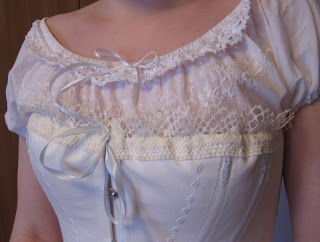I finally got around sewing my Victorian corset! Corset is such an important undergarment for historical sewing as it alters the figure a bit and you should always take measurements for historical sewing wearing the undergarments needed for the outfit.
Here are the supplies I used for this project:
Victorian Corset pattern by Laughing Moon (LM100), I made The Dore Straight Seam Corset. Pattern also includes another corset- The Silverado Bust Gore Corset , a pattern for chemise with three sleeve-alterations and a pattern for open drawers. As main fabric I used heavy cotton drill with no stretch what so ever. For lining I used plain cotton of quilt-weight. Straight busk, 7mm spiral boning, 7mm spiral wire end caps, brass eyelets, boning tape which I didn´t use, cotton tape for waist reinforcement, bias-binding, lace trim, satin tape.
Pattern cutting with Lupi´s assistance. :) I altered the pattern a bit, added length as I´m tall and some basic fit-adjustments. I got plenty of fabric left, at least for one more corset. I was thinking of dying the fabric.
I top-stitched a line of decorative stitching on my machine with viscose machine embroidery thread onto both fronts. It is in white so it blends into main fabric a bit. But the light catches the sheen nicely.
Tools for making eyelets: tape-measure, chalk pen, small scissors, leather punch, eyelets and eyelet-pliers.
Setting the eyelets densely, 17 eyelets per side. I must say I really liked working with pliers, it is so much easier than hammering them and the outcome is smooth. Unlike the hammered ones that always had one side flatter than the other.
All eyelets set in. The pattern instructions suggested having them set before sewing the back parts to the rest of the corset and I must say it was a smart tip. It was much more easy to manipulate the backs without the rest of the corset.
With finished eyelets I got to try on the corset and make a crease for the waistline where the most pressure will be. Here I pinned the cotton tape onto the crease to reinforce the waistline. Then I sewed it onto seam lines with stitch-in-a-ditch method.
Half of the corset without boning. I´m sorry for not taking any pictures of inserting the busk. I got so excited of doing that, that I completely forgot and then the job was done.
Preparing for cutting the bones. Essential tools for this are: tin snips, I prefer these over bolt cutters, needle-nose pliers, you should have two of them, it makes it so much easier to apply U-ends, my other pair is for jewelry making and they do the job,but I will be purchasing another pair for corset-making. And a file in case you need to file off the sharp corners of the steel bones.
Sewing the bias-binding onto both edges with bones inside. Using the zipper foot to be able to stitch near the bones.
Front and back view of the finished corset. I added lace trim and I embroidered flossing onto all bones. Flossing was widely used on Victorian period corsets and it´s function is to encase the ends of the bones and prevent them to tear through the fabric. It also has a decorative function.
Next three pictures are of the embroidery I embroidered by hand on my chemise. The pattern was from 1880 I think. It was great fun doing this. I used one strand of Mouline (stranded cotton). This is a whitework and I found it pretty impossible to take a clear picture of it! The camera just doesn´t know where to focus and all pictures are a bit blur.
Chemise embroidery.
Now that the embroidery is finished I feel anguish to start a new one. But which one?! I should have thought of it before I finished this one and I should have started a new project. That way I wouln´t feel so lost and I could have just continue my already started new project.
Top flossing. Flossing is made with 3 strands of Mouline (stranded cotton) in pale ice-blue color to match the lacing.
Bottom flossing.
Front of the corset. Again this was difficult to photograph because the corset is white.
Back of the corset.
Overall I am happy with the outcome. The corset fits very well. I am able to sit and move in it but I can´t bend all the way to reach the floor. I am surprised of this as I used spiral boning that is known to be flexible. Well, I made a truly Victorian corset as ladies back then were not able to bend down hence they put on their shoes before the corset :)



















No comments:
Post a Comment